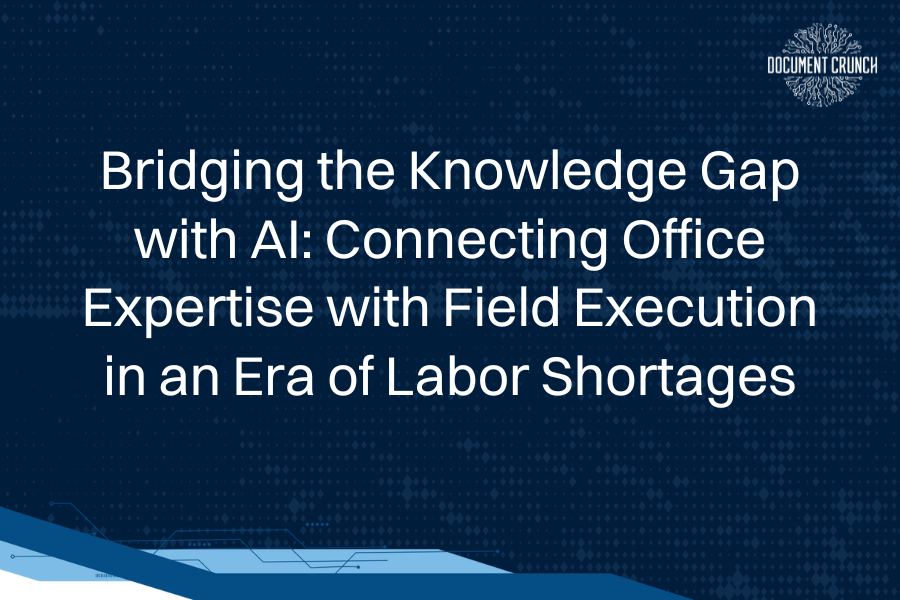Bridging the Knowledge Gap with AI: Connecting Office Expertise with Field Execution in an Era of Labor Shortages


Construction teams have always faced operational hurdles and real-world risks, but today, there are two additional challenges causing a tipping point in the industry and putting projects and profitability on the line. Both pertain to knowledge gaps: a growing exodus of expert knowledge and persistent information silos that keep critical insights and knowledge locked away. Here’s a closer look and what you can do about it…
As experienced construction professionals retire, decades of proven judgment, lessons learned, and practical know-how are disappearing from the industry. Meanwhile, vital information remains scattered across systems, trapped in dense documents, or siloed in individual heads, rarely reaching the people who actually need it when they need it most. The result? Missed risks in bids, misaligned expectations locked into contracts, costly surprises during execution, and ultimately, disputes that strain relationships and erode margins.
But the most forward-thinking firms are changing this narrative. They’re proactively tackling these vulnerabilities by preserving institutional knowledge, codifying proven best practices, and creating streamlined workflows that empower every project stakeholder throughout the project lifecycle.
The Expertise Exodus Is Underway
The construction workforce is aging out at a staggering pace. By 2031, 41% of today’s workers are expected to retire, taking with them decades of practical know-how, trusted judgment, and hard-won lessons from the field. What’s leaving isn’t just manpower; it’s the proven playbooks that kept projects moving and margins protected.
Without a strategy to capture and transfer this expertise, companies are forced to relearn the same painful lessons, project after project. And with tighter margins and leaner teams, the stakes have never been higher.
The Hidden Costs of Information Silos
At the same time, most construction teams are still managing projects with fragmented systems. Contracts live in one platform, specs and plans in another, field updates in yet another, while the people responsible for executing are left piecing it all together.
These silos do more than slow things down. They create blind spots that lead directly to rework, delays, and disputes; costing time, eroding profits, and putting relationships at risk. In an industry where the average cost of a dispute is $42.8 million, it’s a risk few teams can afford. It’s no wonder that, according to the same Arcadis study, 36% of industry leaders say effective risk management is the single most powerful way to avoid claims.
Why AI Is Built for This Challenge
That’s where AI is redefining the landscape. AI isn’t just another tool in the tech stack—it’s a transformative capability uniquely suited to close the construction industry’s widening knowledge gap. First, AI captures and codifies institutional knowledge, turning decades of expertise buried in past contracts, specs, and RFPs into a future resource for teams and projects. Second, it can reinforce sound judgment by identifying patterns, inconsistencies, and potential risks in complex documents, mirroring the decision-making of seasoned professionals. Third, it removes barriers to access by allowing anyone on the team—from the back-office to the field—to ask natural-language questions and get instant, role-specific answers with no legal or software expertise required. And finally, AI continuously learns, integrating feedback from real-world project outcomes to deliver smarter, more relevant guidance over time. In short, AI doesn’t just help teams work faster—it helps them work smarter, with the full weight of the company’s knowledge behind every decision.
While the full potential of AI is still unfolding, its impact is already real and growing. Today, AI-powered solutions like Document Crunch are helping teams take meaningful steps forward.
A New Approach to Knowledge Management
At Document Crunch, we believe AI should do more than just flag risk. It should actively bridge the knowledge gap that’s widening across construction teams, and that’s exactly what our CrunchAI™ helps make possible. As the engine behind our AI Risk Reduction Platform, CrunchAI™ is purpose-built for construction with a deep understanding of the industry’s unique language, workflows, and documents. While general-purpose AI can process language, CrunchAI™ goes further, applying domain-specific intelligence to surface critical insights, streamline reviews, and make institutional knowledge accessible to everyone on the team throughout the project lifecycle. Here’s how:
Codify Best Practices:
With Checklists and Project Playbooks, Document Crunch enables companies to transform decades of hard-won knowledge and expertise into clear, repeatable processes. It doesn’t just capture what your experts look for; it captures how they think, what they prioritize, and how they balance risk in contracts and other project documents. In doing so, it helps eliminate knowledge bottlenecks and reduce reliance on a shrinking pool of experts.
Support Real-Time Execution:
Whether drafting notices, navigating payment applications, or managing change orders, CrunchAI™ assists teams quickly by putting actionable information into their hands right when they need it. With Playbooks that lay out how to follow the contract, plus an on-demand, conversational Chat, teams can act with confidence, stay compliant, and keep projects moving. This means less guesswork and fewer phone calls back to the office.
Connect Every Role, Across Every Phase:
From bid pursuit through closeout, Document Crunch connects your entire project team—estimators, risk managers, legal, project managers, and engineers—around a shared understanding of risk. By surfacing the right information at the right time, in context and in plain language, Document Crunch shortens the learning curve, reduces surprises, and protects margins. Most importantly, it embeds the judgment and experience of your most seasoned professionals directly into every project, preserving what’s known before it’s gone.
Measurable Results in the Field
This isn’t theory. Leading companies like Dant Clayton are already proving how closing knowledge gaps delivers tangible results. By using Document Crunch to standardize and accelerate reviews, their team cut the time spent manually reading obligations from three hours to just 45 minutes per document, saving 25 hours every week—time now redirected toward higher-value priorities.
“This transformation has not only improved the accuracy of contract reviews but has also become a valuable learning experience for the team. What might have once seemed like minimal risk is now carefully assessed and better understood, fostering professional growth and enabling the team to navigate contracts with greater expertise and confidence.” – Coe Norton, Senior Project Manager, Dant Clayton
But the benefits extend well beyond efficiency. With AI-generated Playbooks, tailored Checklists, and an on-demand Chat that breaks down even the most complex provisions, Dant Clayton has embedded its experts’ judgment into repeatable processes. That frees their most experienced professionals to concentrate on complex negotiations and project strategy, while also helping them build talent from within. By eliminating knowledge bottlenecks and creating a safe environment where junior staff can ask targeted questions without hesitation, Document Crunch is actively boosting team confidence and accelerating learning curves. Read more about Dant Clayton’s story here.
Building a More Resilient Workforce
At its core, this isn’t only about adopting new technology, it’s about future-proofing your business. When knowledge transfer is built into your process, you’re better prepared for turnover, able to scale quickly, and more resilient against the unexpected. The most forward-looking teams aren’t waiting for expertise to walk out the door. They’re capturing it now, embedding it in how they work, and empowering everyone from office to field, to make decisions that reduce disputes, protect relationships, and strengthen margins. We’re entering a new era of construction where teams are supported by AI, guided by data, and united by shared knowledge. At Document Crunch, we’re proud to help lead this shift.